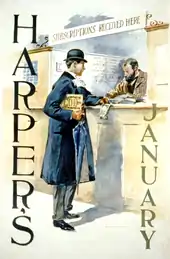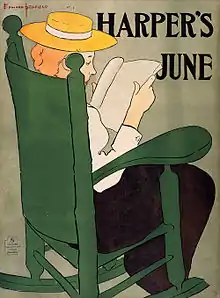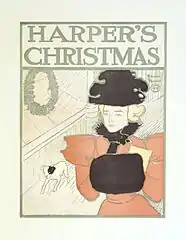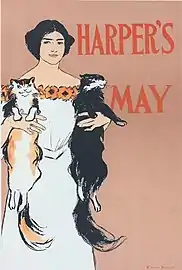Harper's Magazine
Harper's Magazine is a monthly magazine of literature, politics, culture, finance, and the arts. Launched in New York City in June 1850, it is the oldest continuously published monthly magazine in the United States. While Scientific American, founded in 1845, is older, it did not become monthly until 1921. Harper's Magazine has won 22 National Magazine Awards.[1]
 November 2004 issue | |
| Editor | Christopher Beha |
|---|---|
| President | John R. MacArthur |
| Categories | Art, culture, literature |
| Frequency | Monthly |
| Total circulation (2018) | 104,882 |
| First issue | June 1850 (as Harper's New Monthly Magazine) New York City |
| Company | Harper's Magazine Foundation |
| Country | United States |
| Based in | 666 Broadway, New York City, New York, U.S. |
| Language | English |
| Website | harpers |
| ISSN | 0017-789X |
Throughout the 19th and 20th centuries, the magazine published works of hugely prominent authors and political figures, including Herman Melville, Woodrow Wilson, and Winston Churchill. Willie Morris's resignation as editor in 1971 was considered a major event, and many other employees of the magazine resigned with him. The magazine has developed into the 21st century, adding several blogs.
History
19th century
.jpg.webp)

Harper's Magazine began as Harper's New Monthly Magazine in New York City in June 1850, by publisher Harper & Brothers. The company also founded the magazines Harper's Weekly and Harper's Bazaar, and grew to become HarperCollins. The first press run of Harper's Magazine included 7,500 copies and sold out almost immediately. Six months later, the magazine's circulation had grown to 50,000.[2]
The early issues reprinted material pirated from English authors such as Charles Dickens, William Makepeace Thackeray, and the Brontë sisters.[3] The magazine soon was publishing the work of American artists and writers, and in time commentary by the likes of Winston Churchill and Woodrow Wilson. Portions of Herman Melville's novel Moby-Dick were first published in the October 1851 issue of Harper's under the title, "The Town-Ho's Story", named after Chapter 54 of Moby-Dick.[4]
20th century
In 1962, Harper & Brothers merged with Row, Peterson & Company, becoming Harper & Row (now HarperCollins). In 1965, the magazine was separately incorporated, and became a division of the Minneapolis Star and Tribune Company, owned by the Cowles Media Company.
In the 1970s, Harper's Magazine published Seymour Hersh's reporting of the My Lai Massacre by United States forces in Vietnam. In 1971, editor Willie Morris resigned under pressure from owner John Cowles, Jr., prompting resignations from many of the magazine's star contributors and staffers, including Norman Mailer, David Halberstam, Robert Kotlowitz, Marshall Frady, and Larry L. King:
Morris's departure jolted the literary world. Mailer, William Styron, Gay Talese, Bill Moyers, and Tom Wicker declared that they would boycott Harper's as long as the Cowles family owned it, and the four staff writers hired by Morris—Frady among them—resigned in solidarity with him.
Robert Shnayerson, a senior editor at Time magazine, was hired to replace Morris as Harper's ninth editor, serving in that position from 1971 until 1976.[6][7]
Lewis H. Lapham served as managing editor from 1976 until 1981; he returned to the position again from 1983 until 2006. On June 17, 1980, the Star Tribune announced it would cease publishing Harper's Magazine after the August 1980 issue, but on July 9, 1980, John R. MacArthur (who goes by the name Rick) and his father, Roderick, obtained pledges from the directorial boards of the John D. and Catherine T. MacArthur Foundation, the Atlantic Richfield Company, and CEO Robert Orville Anderson to amass the $1.5 million needed to establish the Harper's Magazine Foundation. It now publishes the magazine.[8][9][10]
In 1984, Lapham and MacArthur, now publisher and president of the foundation, respectively, along with new executive editor Michael Pollan, redesigned Harper's and introduced the "Harper's Index" with statistics arranged for , "Readings", and the "Annotation" departments to complement its fiction, essays, reportage, and reviews.
21st century
Under the Lapham and MacArthur's leadership, Harper's Magazine continued publishing literary fiction by John Updike, George Saunders, and others. Politically, Harper's has been a vocal critic of U.S. domestic and foreign policies. Editor Lapham's monthly "Notebook" columns have lambasted the Clinton and the George W. Bush administrations. Beginning in 2003, the magazine concentrated on reportage the Iraq War, including long articles on the battle for Fallujah, and the cronyism of the American reconstruction of Iraq. Other reporting has covered abortion issues, cloning, and global warming.[11]
In 2007, Harper's added the No Comment blog by attorney Scott Horton about legal controversies, Central Asian politics, and German studies. In April 2006, Harper's began publishing the Washington Babylon blog on its website,[12] written by Washington, D.C. editor Ken Silverstein about American politics; and in 2008, Harper's added the Sentences blog by contributing editor Wyatt Mason, about literature and belles lettres. Since that time, these two blogs have ceased publication. Another website feature, featuring a rotating set of authors, is the "Weekly Review", a three-paragraph distillation of the week's political, scientific, and bizarre news. Like "Harper's Index" and "Findings" in the print edition of the magazine, "Weekly Review" items are typically arranged for ironic contrast.
As of the December 2019 issue, Julian Lucas writes the print edition's "New Books" column.
Controversies
Editor Lewis H. Lapham was criticized for his reportage of the 2004 Republican National Convention, which had yet to occur, in his essay "Tentacles of Rage: The Republican Propaganda Mill, a Brief History", published in the September 2004 issue, which implied that he had attended the convention. He apologized in a note.[13][14] Lapham left two years later, after 28 years as Harper's editor-in-chief, and launched Lapham's Quarterly.
The August 2004 issue contained a photo essay by noted photojournalist Peter Turnley, who was hired to do a series of photo essays for the magazine. The eight-page spread in August 2004 showed images of death, grieving, and funerals from both sides of the war in Afghanistan. On the U.S. side, Turnley visited the funeral of an Oklahoma National Guard member, Spc. Kyle Brinlee, 21, who was killed when his vehicle ran over an improvised explosive device (IED) in Afghanistan. During his funeral, Turnley photographed the open casket as it lay in the back of the high school auditorium where the funeral was held to accommodate 1,200 mourners, and the photo was used in the photo essay. Brinlee's family subsequently sued the magazine in federal court. The case ended in 2007 when the U.S. Supreme Court ruled that the unauthorized publication was in "poor taste" but upheld the ruling of the Tenth Circuit that the magazine had not violated the privacy rights of the family, since the family had invited the press and, according the court, "opened up the funeral scene to the public eye".[15]
The March 2006 issue included an article by Celia Farber, "Out of Control: AIDS and the Corruption of Medical Science", presenting Peter Duesberg's theory that HIV does not cause AIDS.[16][17] It was strongly criticized by AIDS activists,[18] scientists and physicians,[19] the Columbia Journalism Review,[20] and others as inaccurate and promoting a scientifically discredited theory.[21] The Treatment Action Campaign, a South African organization working for greater popular access to HIV treatments, posted a response by eight researchers documenting more than 50 errors in the article.[22]
In 2006, Lapham was succeeded as Harper's editor by Roger Hodge.[23] Since that time, the magazine has had a number of shorter-termed editors in chief, several of whom were fired amid various controversies.[23] On January 25, 2010, the firing of the magazine's editor, Roger Hodge, by publisher John R. MacArthur was met with criticism among the magazine's subscribers and staff.[24][25][26] MacArthur initially claimed Hodge was stepping down for "personal reasons", but later disclosed that he fired Hodge.[27]
Ellen Rosenbush served as editor from 2010 to 2015. She returned in January 2016 when MacArthur fired Christopher Cox, who had been named editor only three months prior in October 2015.[23][28]
James Marcus assumed the post of editor in 2016.[23] In March 2018, an essay by Katie Roiphe on the #MeToo movement excited controversy both online and inside Harper's. Marcus had complained about the piece, suggesting the critique of #MeToo was inappropriate in light of Harper's "longtime reputation as a gentleman's smoking club"; he attributed this disagreement as a primary cause of his firing in 2018.[23] In April 2018, Ellen Rosenbush assumed the title of editorial director. In October 2019, the magazine announced that novelist and essayist Christopher Beha would be taking over as editor, with Rosenbush remaining as editor-at-large.[29]
In July 2020, Harper's published an open letter called "A Letter on Justice and Open Debate" criticizing "illiberalism" and promoting a tolerance of different viewpoints. The letter received a mixed response on Twitter with some remarking that the prominent signatories had "bigger platforms and more resources than most other humans" and were unlikely to face repercussions for anything they said, and others taking umbrage at particular signatories such as J. K. Rowling, who faced recent criticism for her comments on transgender issues.[30][31]
Notable contributors
- Horatio Alger
- Frederic H. Balfour
- Wendell Berry
- John Dickson Carr
- John R. Chapin
- Noam Chomsky
- Winston Churchill
- Florence Earle Coates
- Alexander Cockburn
- Diane Cook
- Rebecca Curtis
- Roald Dahl
- Bernard DeVoto
- Stephen A. Douglas
- Theodore Dreiser
- Irwin Edman
- Barbara Ehrenreich
- Ralph Ellison
- Sol Eytinge Jr.
- Lucine Finch
- Thomas Frank
- Jonathan Franzen
- Robert Frost
- Barbara Garson
- John Taylor Gatto
- Horace Greeley
- Barbara Grizzuti Harrison
- Seymour Hersh
- Christopher Hitchens
- Edward Hoagland
- Richard Hofstadter
- Winslow Homer
- Jim Hougan
- Irving Howe
- William Dean Howells
- Henry James
- Naomi Klein
- Ben Lerner
- Jack London
- Fitz Hugh Ludlow
- Norman Mailer
- Herman Melville
- Stanley Milgram
- John Stuart Mill
- Hamilton Morris
- John Muir
- Thomas Nast
- Albert Jay Nock
- Joyce Carol Oates
- Cynthia Ozick
- Kevin Phillips
- Marjorie Pickthall
- Sylvia Plath
- Michael Pollan
- Frederic Remington
- Marilynne Robinson
- Richard Rodriguez
- Theodore Roosevelt
- Philip Roth
- J. D. Salinger
- George Saunders
- Miranda July
- David Samuels
- Herman George Scheffauer
- Isaac Bashevis Singer
- Jane Smiley
- Zadie Smith
- Rebecca Solnit
- Terry Southern
- John Steinbeck
- Henry L. Stimson
- Alfred Thomas Story
- Susan Straight
- Booth Tarkington
- Sara Teasdale
- Hunter S. Thompson
- Mark Twain
- John Updike
- Kurt Vonnegut
- William T. Vollmann
- Adelaide Cilley Waldron
- David Foster Wallace
- H. G. Wells
- E. B. White
- Woodrow Wilson
- Owen Wister
- Tom Wolfe
- Howard Zinn
- Slavoj Žižek
Gallery
- Posters by Edward Penfield
 January 1894
January 1894 January 1895
January 1895 June 1896
June 1896 December 1896
December 1896 May 1897
May 1897
References
- "Awards and Honors" (PDF). Harpers.org. Archived from the original (PDF) on 29 September 2006. Retrieved 29 December 2014.
- "History of Harper's" (PDF). Harpers.org. Archived from the original (PDF) on 18 February 2007. Retrieved 29 December 2014.
- "Gale Encyclopedia of U.S. History: Publishing Industry". answers.com. Retrieved 2013-02-13.
- "JiffyNotes: Moby Dick: Summary: Chapters 51 – 55". Jiffynotes.com. Archived from the original on 26 December 2014. Retrieved 29 December 2014.
- Scott, Sherman (Nov–Dec 2007). "The Unvanquished". Cjr.org. Retrieved 2012-05-16.
- "The Press: New Head at Harper's". Time. June 28, 1971. Archived from the original on March 12, 2008. Retrieved 2012-05-16.
- "About This Issue". Harper's Magazine. September 1971. Retrieved 2012-05-16.
- Facts on File 1980 Yearbook, pp.501, 582
- Woo, Elaine (December 5, 2007). "Arco founder led firm into major civic philanthropy". Los Angeles Times. p. B6.
- "NY Times Makes Harper's Publisher Look Ineffective". Mediaite.com. February 1, 2010. Retrieved 29 December 2014.
- An American Album: One Hundred and Fifty Years of Harper's Magazine, a 712-page illustrated anthology, with an introduction by Lewis H. Lapham and a foreword by Arthur Schlesinger Jr.
- Harpers.org Archived April 24, 2006, at the Wayback Machine
- Shafer, Jack. "Lewis Lapham Phones It In: Figuring out what's wrong with Harper's magazine". Slate 15 September 2004.
- Lapham, Lewis H. "Tentacles of rage: The Republican propaganda mill, a brief history". Harper's September 2004. pp. 43–53.
- Reporter's Committee for Freedom of the Press, Dismissal upheld in magazine's open-casket photo case, March 28, 2007.
- Farber, Celia (March 1, 2006). "Out Of Control, AIDS and the corruption of medical science". Harper's Magazine. March 2006. Retrieved 2006-03-13.
- Miller, Lia (March 13, 2006). "An Article in Harper's Ignites a Controversy Over H.I.V." The New York Times. Retrieved 2006-03-13.
- Farber Feedback. POZ Magazine. 2006-02-27. Retrieved 2006-03-13.
- Letters from scientists and physicians criticizing Harper's for poor fact-checking of Celia Farber's article on AIDS. Accessed 21 Oct 2006. Archived August 12, 2006, at the Wayback Machine
- Harper's Races Right over the Edge of a Cliff, by Gal Beckerman. Published in the Columbia Journalism Review on March 8, 2006. Accessed June 14, 2007.
- Kim, Richard (March 2, 2006). Harper's Publishes AIDS Denialist. Retrieved 2006-03-13.
- Gallo, Robert; Nathan Geffen; Gregg Gonsalves; Richard Jeffreys; Daniel R. Kuritzkes; Bruce Mirken; John P. Moore; Jeffrey T. Safrit (March 4, 2006). Errors in Celia Farber's March 2006 article in Harper's Magazine (PDF). Treatment Action Campaign. Archived from the original (PDF) on 2009-06-16. Retrieved 2006-03-13.
- Jaclyn Peiser, "Harper's Editor Insists He Was Fired Over Katie Roiphe Essay", The New York Times, April 18, 2018.
- Clifford, Stephanie (January 31, 2010). "Editorial Shake-Up as Harper's Tries to Stabilize in a Downturn". The New York Times. Retrieved 29 December 2014.
- "Harper's Publisher Backlash Grows After Firing Beloved Editor". Mediaite.com. February 3, 2010. Retrieved 29 December 2014.
- John Koblin (2010-02-02). "Listening in on the Harper's Meltdown". The New York Observer. Retrieved 29 December 2014.
- Clifford, Stephanie (January 26, 2010). "Update: Harper's Magazine Editor Hodge Fired; Didn't Quit". The New York Times. Retrieved 29 December 2014.
- Alexandra Alter (2016-02-02). "Harper's Magazine Publisher Fires Christopher Cox as Editor". The New York Times. Retrieved 18 May 2016.
- Tracy, Marc (2019-10-21). "A New Top Editor Takes the Hot Seat at Harper's Magazine". The New York Times. ISSN 0362-4331. Retrieved 2019-10-24.
- Schuessler, Jennifer; Harris, Elizabeth A. (7 July 2020). "Artists and Writers Warn of an 'Intolerant Climate.' Reaction Is Swift". The New York Times. Retrieved 9 July 2020.
- Chiu, Allyson (8 July 2020). "Letter signed by J.K. Rowling, Noam Chomsky warning of stifled free speech draws mixed reviews". The Washington Post. Retrieved 9 July 2020.
Further reading
- Gabler-Hover, Janet; Robert Sattelmeyer, eds. (2006). "Book and Periodical Illustration in America, 1820–1870". American History Through Literature, 1820–1870. Vol. 1. Detroit: Thomson/Gale. pp. 144–48. ISBN 9780684314600. OCLC 1102155210.
- Lilly, Thomas (2005). "The National Archive: Harper's New Monthly Magazine and the Civic Responsibilities of a Commercial Literary Periodical, 1850–1853". American Periodicals. Vol. 15, no. 2. pp. 142–162. JSTOR 20771182.